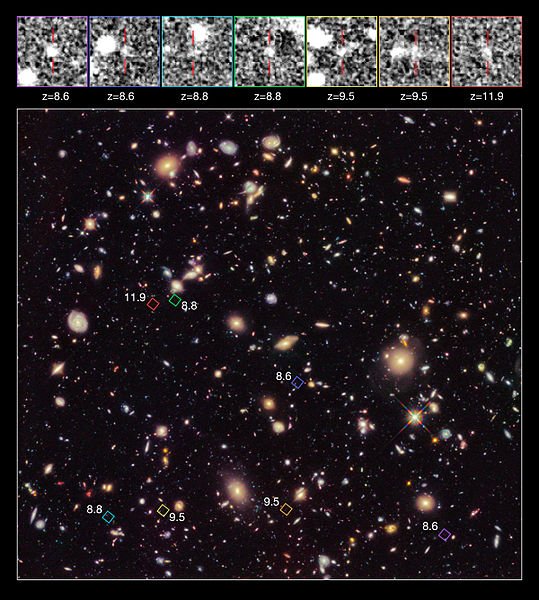STEM Breakthrough Contest: Harnessing the Tera-hertz Spectrum

This is an entry for the STEM contest being run by stemgeeks and @themarkymark. You can join the STEM contest fun here!
I'm having great fun with this STEM contest! I have had so many random things that I've been wanting to blather and gush about... but this contest gives me the kick in the arse to actually post a brief foray into some of these topics! Well, at the very least, it has taken over my blog for this week!
So, the next topic that I think will be an important breakthrough for humanity in the coming decade is the possibility of harnessing and more efficient detection of the Tera-Hertz portion of the EM spectrum. This is a topic that I only had a passing knowledge about (mostly due to the first application listed below, Looking Back in Time)... but recently, I had attended an inauguration lecture by a friend, whose specialist field is in Tera-Hertz Imaging (and she's pretty top in it!!!!).... and so, it is on my mind at the moment and also introduced me to other applications of the technology that I had no idea about!
So, this is a brief wrap up of the potentials of this technology... I will try to write a more in-depth one based on what I had learnt from the lecture at a later time!

Tera-what?

No... nothing to do with the Earth (that is Terra...) and no pain involved (haha... hurts?). The Tera-Hertz (also known as sub-millimetre) section of the Electromagnetic (EM, don't make me write it in full every time...) Spectrum is the section between the far-infrared and the beginning of the microwave bands of the EM spectrum. So, it has a lower frequency (longer wavelength) than visible light and a higher frequency (shorter wavelength) in comparison to radio waves.
The current problems in detection in this spectrum is that due to the lower frequency, it is much less energetic than visible light... and thus harder to detect. So, regular cameras which can easily detect the comparatively high energy visible light spectrum will just not be adequate for Tera-Hertz detection. However, radio waves (used in all our electronic communications at the moment) are orders of magnitude weaker... but benefit from having the existence of electronic amplifiers which are sensitive at this range and can boost the signals.
So, Tera-Hertz lies in this awkward detection gap... too weak for unassisted detection and in the wrong part for our current modes of assisted detection. If only we knew how to detect and harness this part of the spectrum on a large commercial scale! Yep... that is what my friend is working on... I'll check in next week to see if she has finished it, or if it just sitting on a list of things to do...

Looking Back in Time

Okay... I'm going to lead with perhaps the MOST abstract application of this technology.... on the other hand it is the most interesting part of the whole thing, and I'm writing this post... so, I get to choose the order!
In the image above, we have the Deep Field View from the Hubble telescope... it's pretty damn amazing in it's own right, having captured the very distant universe, things that were otherwise impossible to see from Earth. It is also a story in allowing scientists to pursue their curiosity (and not be restricted by a politician's "common sense").... back when Hubble was new, a proposal was made to point the telescope for months at a patch of nothingness in the sky... so, a patch of the sky where there was absolutely NOTHING interesting to look at. Of course, this idea met resistance from the usual nay-sayers and bean-counters. You launched a space telescope, costing countless millions... to look at NOTHING?!?!?!?!
Well... it turns out that if you look long enough... you can capture the few photons that are making their way in from much further away in the Universe... so, we expanded our estimation of how populated and huge the Universe really was!... and so, there is a story about why you should just let scientists do their work and pursue curiosity driven ideas rather than what some idiot thinks is "common sense". (/rant)
Redshift (light from distant objects gets shifted in the red direction of the EM spectrum, due to the expansion of the Universe in the intervening travel time) from faraway galaxies means that all the images that are detected by Hubble are in the visible or infrared portions of the spectrum. This means that there is a cap as to how far back in time (or how far away...) we can look. Now, if there was only a way to reliably detect an object that was further away (so, it would be redshifted into the Tera-Hertz range).
A Prototype detector was created recently just for this purpose... and found success in detecting objects that the Hubble Deep Field could not detect... so, in essence, we are looking even further back in time to the age of the first galaxies! AWESOME... and completely USEFUL (who cares if it isn't...)!

Communication

Terahertz by definition has a much higher bandwidth than regular radio waves... however, the problem has long been one of detection and lack of amplifiers. It is also a much tighter form of communication, as the smaller wavelength means that the beam isn't diffracted as badly, so the power of transmitters could be reduced by orders of magnitudes (given the development of commercial detectors)..
Of course, it does come with the disadvantage of dissipation over distance... and the problem of line of sight communication only... both of which can be solved with detector/transmitter chains. Besides line of sight communication is also a better security model anyway... rather than blasting out radio waves sperically to anyone who might be interested!
So, magnitudes of orders higher data rates... at orders of magnitude lower energy cost?! Win win!

Detection

In comparison to X-Rays, Tera-Hertz radiation is non-ionising.. this means that each individual photo doesn't have enough energy to punch out an electron from one of your precious body cells or DNA. Thus, it is a better non-invasive alternative to medical imaging.... or security! In fact, the European airports already do use a form of close range Tera-Hertz detectors for looking under your clothes...
However, with better detectors... you could just walk past a wall of detectors... a corridor maybe... the days of stupid airport lines could be a thing of distant memory... something that you tell your children along with the stories of how we used to set things on fire to produce electricity!
Detection could also work in an automation (cars and machinery) setting... TeraHertz detectors wouldn't be thrown off by rain or other weather conditions as easily as the current visual and radio wave based detectors. At the very least, it would add another layer of detection in an otherwise time-critical application.

Conclusion
Okay... so there is a bit of bias here... TeraHertz is a known quantity in an abstract sense... however, the application and the harnessing of this part of the spectrum is not something that has been "broken through"... at least not in a commercials sense. There are prototypes and research sensors... ,but these are big and unwieldy and require a good amount of support equipment.
Commercial scale detectors would open the doors to large bandwidth advances (something critical for many upcoming technologies) and energy savings (always a good thing) in Communcation settings; it would also find it's place in security and detection settings; and most importantly allow us to look further back in time as we probe the most distant (and youngest) portions of the Universe!

Account banner by jimramones


@tipu curate
Upvoted 👌 (Mana: 5/20 - need recharge?)
Thanks for the curation!
Congratulations @bengy! You have completed the following achievement on the Steem blockchain and have been rewarded with new badge(s) :
You can view your badges on your Steem Board and compare to others on the Steem Ranking
If you no longer want to receive notifications, reply to this comment with the word
STOPVote for @Steemitboard as a witness to get one more award and increased upvotes!
Good luck winning the contest!
Thanks! Hope you enjoyed the read!
What a great read! I'm particularly interested in the safer medical and security uses for this. It baffles me as to why this hasn't been used already, and get some comfort from knowing it is in use in places in Europe. Not that I like strangers looking under my clothes!
I wonder what a thermogram does now, and they operate on the tera-hertz level.
Were you referring to 5G with this rather than blasting out radio waves sperically to anyone who might be interested
assuming you meant spherically?
Excellent post I really enjoyed it.
Thanks, glad you found it interesting. The security use case (as it stands at the moment) is easier, as there is a greater difference in reflection between a metal object and human bits... plus, you aren't trying to look past anything more than a thin layer of clothing... so, the current crude detectors are fine for this job. The ones in Europe are pretty cool... of course, the imaging isn't quite the same as looking under your clothes!
For a more advanced use case (medical and advanced security with no need to partially disrobe and stand still...).. you would require much better detectors, and that is what my friend is working on.
A thermogram (just a quick guess based on the name) is likely to use infrared for detection, this is again a simpler problem (we have IR detectors...) as the photon energy is greater (but still less than visible light), the Tera-hertz range lies a bit further away from visible compared to IR. I'm not sure, but possibly one of the limitations of the IR technique would be getting resolution under too many layers of flesh?
This is similar in transmission style to 5G... however, 5G still uses radio waves (millimetre band I think...) to get large data rates at the cost of penetration. However, these waves are still able to be amplified by electronic receiver/amplifiers.. Tera-Hertz doesn't yet have a commercially available detector/amplifier... and would also result in orders of magnitudes greater data rate. I'm not really up to speed on exactly how 5G does the transmission, I'm not really sure if it is directional or not!
Again, take my answers with a grain of salt... I'm not a communications engineer or an expert in the field... just a interested amateur with a prior background of tertiary study... so, just enough rope to hang myself!
haha. You are a brave soul then. I dream of doing math contests, but the younger minds on steem work at lightening speed compared to mine now. Maybe a math post someday. For now, creative writing is my obsession. No one wants to hang me no matter what I say.
Thanks for all that info. Really nice work, photos, text, content.
You should do a Math post! I was scared for a long time to do a STEM style post... but people are quite forgiving here!
Hello,
Your post has been manually curated by a @stem.curate curator.
We are dedicated to supporting great content, like yours on the STEMGeeks tribe.
Please join us on discord.
Thanks for the curation and support!
We are SO proud to have you as a member of our
FANTABULOUS Power House Creatives family!
uvoted and/or resteemed!
❤ MWAH!!! ❤
#powerhousecreatives
Posted using Partiko Android
Thanks for the support!